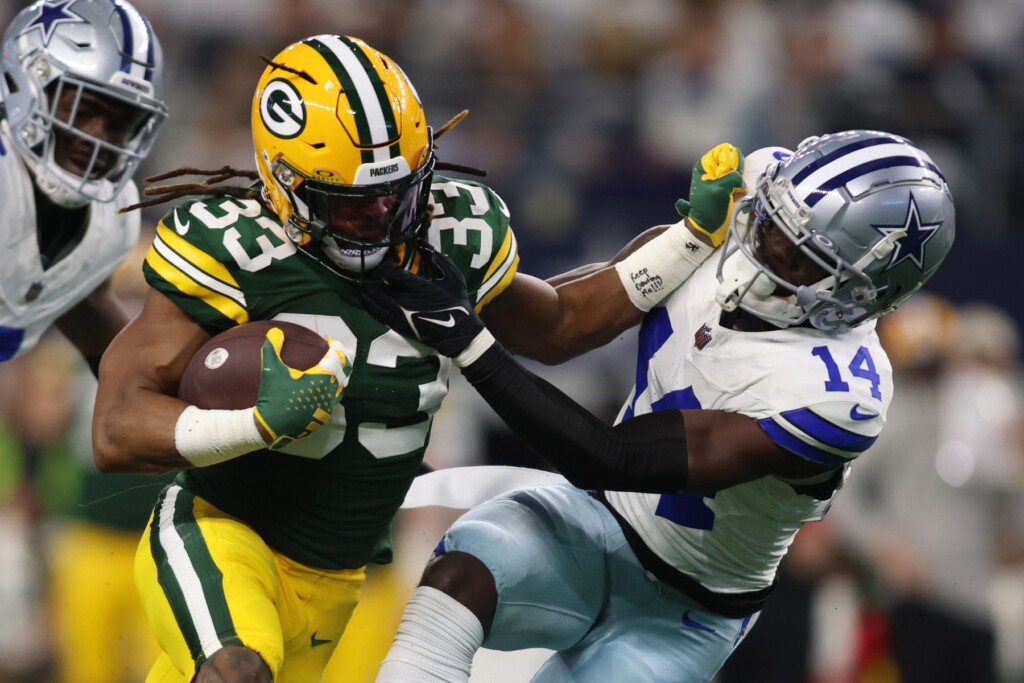It’s hard to keep track of how many times we’ve had to eulogize a Cowboys season like this one.
The 2023 edition of the Dallas Cowboys held the league’s best home-field point differential and went into the playoffs as a seven-point home favorite. The 2023 edition of Dak Prescott finished the year with the second-best odds to win the league MVP. The 2023 edition of CeeDee Lamb set franchise records for receptions and receiving yards. The 2023 edition of DaRon Bland turned in one of the greatest seasons for a defensive back in NFL history. The 2023 edition of Micah Parsons remained one of the league’s most fearsome defenders (and isn’t afraid to tell us about it). But the only fact that seemed to matter at the end of the year was that this was but a new edition of the same old Cowboys.
For the third straight year, the Cowboys finished the regular season with a 12-5 record yet failed to turn it into at least an appearance in the NFC championship game. Over the past decade, the Cowboys have had six seasons with 10 or more wins yet have never made it past the divisional round. Only the Baltimore Ravens can match that level of regular-season success paired with postseason disappointment, all that’s standing between the AFC’s top seed and the conference championship game are the Cinderella Texans, which would leave Dallas all alone at the… top? Bottom? How about we call it a plateau?
We’re all familiar with the season as a whole by now, but there’s still plenty to tell about how the team went out with a whimper against the seventh-seeded Green Bay Packers. Everything seemed to go wrong early and often, but there’s one number that best sums up where the Cowboys’ largest failure came from: 61.
Through three quarters on Sunday, the Packers ran a successful play on 61 percent of their 41 snaps—successful being defined as any play with a positive EPA, which in general means a play that increased the odds an offense would score points on that series. To put that into context: over the 272 games played in the 2023 regular season, only 11 teams gave up at least a 61 percent success rate through three quarters of play. The league-average success rate during the regular season was about 43 percent. Dallas picked the worst time to have not only its worst defensive game of the year, but also one of the worst defensive games from any team.
Now to be clear, isolating only the first three quarters isn’t entirely fair—we are throwing out a quarter of the game. But this fourth quarter began with Green Bay holding the ball and a four-score lead, at 41-16. The Packers dropped back to pass only three times in the final quarter, with the ball traveling a total—not average, but total—of 4 yards through the air. Meanwhile, 73 percent of their runs came from their third- and fourth-string running backs. Safe to say the Packers were already looking ahead to the divisional round.
The thing about this defensive collapse is that you can’t pinpoint just one thing that went wrong. The Cowboys couldn’t stop Jordan Love, who finished with a near-perfect passer rating, didn’t commit a turnover, and wasn’t sacked. And they couldn’t stop Aaron Jones, who was on pace to break 6 yards per carry for the third time this season before two garbage-time carries in the fourth quarter dropped his average to a measly 5.6 yards per carry. Dallas did hold young breakout wide receiver Jayden Reed without a touch, but the problem there is that Green Bay has been spreading the Love to a different receiver each week. On Sunday, Romeo Doubs took the lead and garnered more yards than he had in the past four games combined, with 151 yards on six catches, and Green Bay’s passing attack took off without so much as a speed bump in its way.
The pass defense has largely been a high point for the Cowboys in 2023, thanks largely to Bland’s record-breaking interceptions and Parsons simply existing. But against Green Bay, Parsons only managed one QB hit and zero sacks, while nobody in the secondary except Jayron Kearse had a pass breakup. Bland and fellow cornerback Stephon Gilmore both registered their lowest coverage grades of the season, according to Pro Football Focus, while Jourdan Lewis and safety Donovan Wilson both had their second-worst showings of the season.
A collapse like this gives reason to question not just the players, but also the coaching decisions that went into this game plan. Defensive coordinator Dan Quinn ran one of the most unique defenses in terms of the personnel he put out there week in, week out. Over the course of the regular season, Dallas played in dime personnel (six DBs) for more than half of its snaps—2.5 times more often than the next closest team.
Playing a lot of this personnel isn’t in and of itself a problem, as evidenced by the fact that Dallas fielded a top-five defense in terms of points allowed in the regular season. But what this did do was give opponents who had the right personnel a starting point to build their offensive game plan. Green Bay is one of those teams with the right personnel. The Packers started two tight ends, rookies Tucker Kraft and Luke Musgrave, who are uber-athletic players and stand almost a combined 13 feet tall. Athleticism isn’t easy to measure, but according to at least one method (the Relative Athletic Score), both are in the 96th percentile of all draft-eligible tight ends since 2000. Green Bay took advantage of these rookies along with the Cowboys’ tendency to trot out five defensive backs and came out in 12 personnel (one running back, two tight ends) at a higher rate than it had all season to open the game. And then Green Bay went on a 12-play, 75-yard touchdown drive that burned more than half of the first-quarter clock.
Over the course of the game, the Packers stayed in 12 personnel for 47 percent of their plays. The end result was that at various points in the game, Dallas was stuck matching at least one cornerback (none of whom are within 5 inches of Musgrave or Kraft) on one of these tight ends, who combined to catch five passes for 67 yards and a touchdown. It also meant these defensive backs had to carry the load against a run game that was trotting out two tight ends to help with the run blocking. It was a similar game plan to what we saw in Week 15, when Bills running backs averaged 6.3 yards per carry and ran 12 personnel 33 percent of the time.
It’s not a great look for Quinn, a hot name as a potential head coaching candidate for 2024. But at the same time, he didn’t really have many options. Damone Clark was the only healthy linebacker on the roster. Safety Markquese Bell became the number two linebacker as the season went on, playing 90 percent of his snaps in the box or along the defensive line. Parsons is technically an option to drop into coverage, but he’s also the most explosive pass rusher in the NFL—not the type of guy you want doing anything else. Perhaps this problem was less on Quinn and more on the guys building the roster.
At the end of the day, it’s up to the reader to decide who is most to blame for yet another playoff failure. What’s beyond debate is that the defense collapsed, allowing the Packers to run (and pass) all over it to the tune of a 61 percent success rate for 45 minutes while coasting to victory. Now the Cowboys will face another long offseason that might be full of change.
Author









